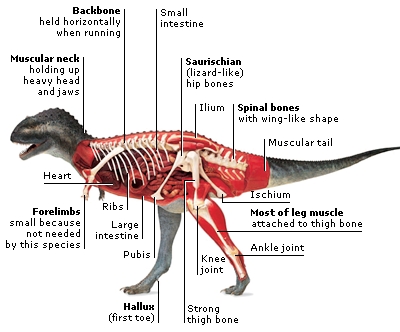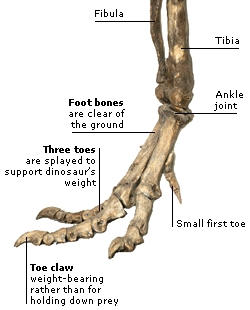DK Science: Bipedal Carnivores
The scientific name for meat-eating dinosaurs is theropods, which means “beast-footed”. These fierce hunting carnivores were saurischian – they had hip bones arranged like those of a lizard. The pubis bone reached forward and down, the ischium bone reached down and back, and the ilium bone along the top held the leg muscles. Most of the carnivores were wholly bipedal, standing and running on their two back legs. Many, such as the efficient predators Deinonychus and Suchomimus, had long fingers and claws on their front legs, which they used to grip food or slash prey.
The digestive system of a carnivorous dinosaur was very much like that of today’s reptiles, such as the crocodile. The food would have travelled into the stomach, been processed, and then passed out through the intestines. Many carnivore fossils have cavities in the bones, which scientists believe are evidence of the existence of air sacs. In modern birds, air sacs help increase the flow of air to the lungs. This would have done the same for the carnivores, making them very active, and giving them the energy they needed to hunt down their prey.
The big carnivores probably had leathery skin that was covered in scales. The only fossil skin found so far comes from Carnotaurus, illustrated here. Like the soft insides of all animals, skin rarely survives as a fossil. Smaller carnivorous dinosaurs may have had more lizard-like skin, and recent discoveries show that some of them had a covering of feathers.
The name theropod was given to carnivorous dinosaurs by 19th-century scientists who thought that dinosaur foot bones were more like those of a mammal than those of a lizard, as in the sauropods, or a bird, as in the ornithopods. A typical theropod foot, such as this one from a Tyrannosaurus, had three main toes – the middle toes. The first toe was much smaller and usually did not touch the ground. The fifth toe was only a splinter of bone.
To order this book direct from the publisher, visit DK's website.







